𝐏𝐡𝐲𝐬𝐢𝐜𝐚𝐥 𝐃𝐞𝐬𝐜𝐫𝐢𝐩𝐭𝐢𝐨𝐧 𝐨𝐟 𝐭𝐡𝐞 𝐁𝐥𝐚𝐜𝐤 𝐒𝐭𝐨𝐧𝐞 (𝐚𝐥-𝐇𝐚𝐣𝐚𝐫 𝐚𝐥-𝐀𝐬𝐰𝐚𝐝)
Mohamad Mostafa Nassar
Twitter:@NassarMohamadMR
𝐅𝐢𝐫𝐬𝐭 𝐓𝐡𝐞 𝐍𝐨𝐛𝐥𝐞 𝐐𝐮𝐫𝐚𝐧 𝐬𝐭𝐚𝐭𝐞𝐬 𝐌𝐮𝐬𝐥𝐢𝐦𝐬 𝐰𝐨𝐫𝐬𝐡𝐢𝐩 𝐓𝐇𝐄 𝐋𝐎𝐑𝐃 𝐎𝐅 𝐓𝐇𝐄 𝐇𝐎𝐔𝐒𝐄 𝐢𝐧 𝐌𝐞𝐜𝐜𝐚 𝐚𝐧𝐝 𝐍𝐎𝐓 𝐭𝐡𝐞 𝐇𝐨𝐮𝐬𝐞 𝐢𝐧 𝐌𝐞𝐜𝐜𝐚 𝐈𝐓𝐒𝐄𝐋𝐅 – 𝐢𝐭 𝐣𝐮𝐬𝐭 𝐚 𝐃𝐈𝐑𝐄𝐂𝐓𝐈𝐎𝐍= 𝐆𝐋𝐎𝐁𝐀𝐋 𝐂𝐎𝐌𝐏𝐀𝐒𝐒 𝐟𝐨𝐫 𝐚𝐥𝐥 𝐌𝐮𝐬𝐥𝐢𝐦𝐬 𝐚𝐫𝐨𝐮𝐧𝐝 𝐭𝐡𝐞 𝐰𝐨𝐫𝐥𝐝 𝐚𝐬 𝐬𝐭𝐚𝐭𝐞𝐬 𝐢𝐧 𝐐𝐮𝐫𝐚𝐧 𝐂𝐡𝐚𝐩𝐭𝐞𝐫 𝟏𝟎𝟔:

𝐂𝐡𝐫𝐢𝐬𝐭𝐢𝐚𝐧 𝐇𝐲𝐩𝐨𝐜𝐫𝐢𝐬𝐲 𝐚𝐧𝐝 𝐭𝐡𝐞 𝐁𝐥𝐚𝐜𝐤 𝐒𝐭𝐨𝐧𝐞 𝐢𝐧 𝐌𝐞𝐜𝐜𝐚
𝐋𝐞𝐭’𝐬 𝐜𝐨𝐦𝐩𝐚𝐫𝐞 𝐛𝐞𝐭𝐰𝐞𝐞𝐧 𝐭𝐡𝐞 𝐛𝐥𝐚𝐜𝐤 𝐬𝐭𝐨𝐧𝐞 𝐢𝐧 𝐈𝐬𝐥𝐚𝐦 𝐚𝐧𝐝 𝐁𝐢𝐛𝐥𝐞 𝐬𝐭𝐨𝐧𝐞 -𝐉𝐨𝐬𝐡𝐮𝐚 𝟐𝟒:𝟐𝟔-𝟐𝟕 𝐢𝐭 𝐬𝐡𝐚𝐥𝐥 𝐛𝐞 𝐚 𝐰𝐢𝐭𝐧𝐞𝐬𝐬 𝐚𝐠𝐚𝐢𝐧𝐬𝐭 𝐮𝐬, 𝐢𝐭 𝐡𝐚𝐬 𝐡𝐞𝐚𝐫𝐝 𝐚𝐥𝐥 𝐭𝐡𝐞 𝐰𝐨𝐫𝐝𝐬 𝐭𝐡𝐞 𝐋𝐨𝐫𝐝 𝐬𝐚𝐢𝐝, 𝐈𝐬𝐚𝐢𝐚𝐡 𝟔:𝟓-𝟕 𝐢𝐭 𝐊𝐈𝐒𝐒𝐄𝐃 𝐬𝐨𝐦𝐞𝐨𝐧𝐞 𝐚𝐧𝐝 𝐟𝐨𝐫𝐠𝐚𝐯𝐞 𝐡𝐢𝐬 𝐬𝐢𝐧𝐬 –
𝐖𝐞 𝐌𝐮𝐬𝐥𝐢𝐦 𝐤𝐢𝐬𝐬 𝐭𝐡𝐞 𝐛𝐥𝐚𝐜𝐤 𝐬𝐭𝐨𝐧𝐞, 𝐛𝐮𝐭 𝐚𝐜𝐜𝐨𝐫𝐝𝐢𝐧𝐠 𝐭𝐨 𝐁𝐢𝐛𝐥𝐞 𝐬𝐭𝐨𝐧𝐞 𝐢𝐭𝐬𝐞𝐥𝐟 𝐤𝐢𝐬𝐬𝐞𝐝 𝐬𝐨𝐦𝐞𝐨𝐧𝐞, 𝐂𝐡𝐫𝐢𝐬𝐭𝐢𝐚𝐧𝐬 𝐝𝐨𝐧’𝐭 𝐭𝐚𝐥𝐤 𝐚𝐛𝐨𝐮𝐭 𝐭𝐡𝐚𝐭, 𝐡𝐨𝐰 𝐜𝐚𝐧 𝐚 𝐬𝐭𝐨𝐧𝐞 𝐤𝐢𝐬𝐬 𝐨𝐭𝐡𝐞𝐫𝐬?
-𝐂𝐡𝐫𝐢𝐬𝐭𝐢𝐚𝐧𝐬 𝐬𝐡𝐨𝐮𝐥𝐝 𝐞𝐝𝐮𝐜𝐚𝐭𝐞 𝐭𝐡𝐞𝐦𝐬𝐞𝐥𝐯𝐞𝐬 𝐚𝐧𝐝 𝐥𝐞𝐚𝐫𝐧 𝐰𝐡𝐚𝐭 𝐢𝐝𝐨𝐥𝐚𝐭𝐫𝐲 𝐢𝐬? 𝐍𝐨𝐧𝐞 𝐨𝐟 𝐭𝐡𝐞 𝐩𝐫𝐨𝐩𝐡𝐞𝐭𝐬 𝐨𝐟 𝐁𝐢𝐛𝐥𝐞 𝐩𝐫𝐚𝐜𝐭𝐢𝐜𝐞𝐝 𝐂𝐡𝐫𝐢𝐬𝐭𝐢𝐚𝐧𝐢𝐭𝐲 𝐧𝐨𝐫 𝐰𝐨𝐫𝐬𝐡𝐢𝐩𝐩𝐞𝐝 𝐭𝐡𝐞 𝐟𝐚𝐥𝐬𝐞 𝐓𝐑𝐈𝐔𝐍𝐄 𝐆𝐨𝐝, 𝐧𝐨𝐫 𝐉𝐞𝐬𝐮𝐬 𝐝𝐢𝐝 𝐭𝐡𝐚𝐭!!! –
𝐂𝐡𝐫𝐢𝐬𝐭𝐢𝐚𝐧𝐬 𝐚𝐫𝐞 𝐟𝐚𝐥𝐬𝐞 𝐖𝐎𝐑𝐒𝐇𝐈𝐏𝐏𝐄𝐑𝐒 𝐚𝐧𝐝 𝐟𝐚𝐥𝐬𝐞 𝐅𝐎𝐋𝐋𝐎𝐖𝐄𝐑𝐒 𝐨𝐟 𝐉𝐞𝐬𝐮𝐬 (𝐉𝐨𝐡𝐧 𝟒:𝟐𝟐-𝟐𝟒)
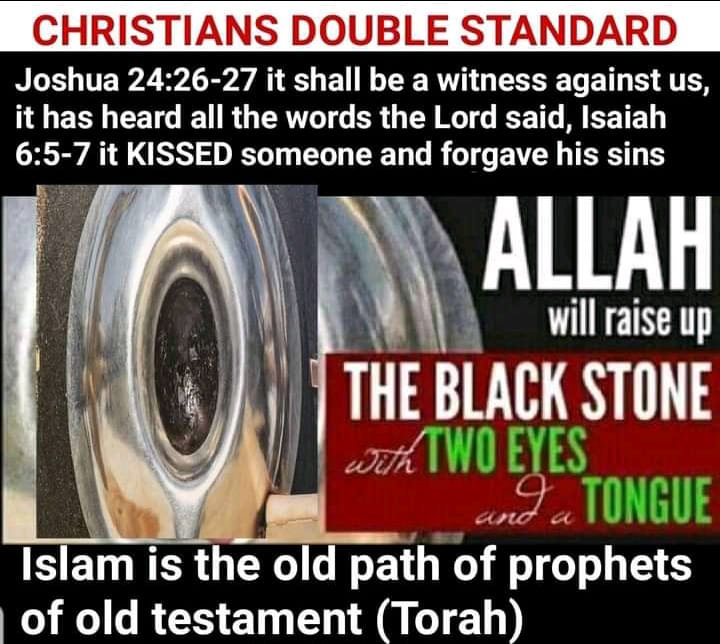
𝐒𝐚𝐝𝐥𝐲 𝐦𝐚𝐧𝐲 𝐧𝐨𝐧-𝐌𝐮𝐬𝐥𝐢𝐦𝐬 𝐡𝐚𝐯𝐞 𝐍𝐎 𝐢𝐝𝐞𝐚, 𝐰𝐡𝐚𝐭 𝐢𝐬 𝐢𝐧 𝐭𝐡𝐞 𝐁𝐢𝐛𝐥𝐞:
(“𝐰𝐞𝐧𝐭 𝐭𝐨 𝐡𝐢𝐬 𝐡𝐨𝐮𝐬𝐞 𝐰𝐡𝐞𝐫𝐞 𝐡𝐞 𝐡𝐚𝐝 𝐰𝐢𝐧𝐝𝐨𝐰𝐬 𝐢𝐧 𝐡𝐢𝐬 𝐮𝐩𝐩𝐞𝐫 𝐜𝐡𝐚𝐦𝐛𝐞𝐫 𝐨𝐩𝐞𝐧 𝐭𝐨 𝐉𝐞𝐫𝐮𝐬𝐚𝐥𝐞𝐦; 𝐚𝐧𝐝 𝐡𝐞 𝐠𝐨𝐭 𝐝𝐨𝐰𝐧 𝐮𝐩𝐨𝐧 𝐡𝐢𝐬 𝐤𝐧𝐞𝐞𝐬 𝐭𝐡𝐫𝐞𝐞 𝐭𝐢𝐦𝐞𝐬 𝐚 𝐝𝐚𝐲 𝐚𝐧𝐝 𝐩𝐫𝐚𝐲𝐞𝐝 𝐚𝐧𝐝 𝐠𝐚𝐯𝐞 𝐭𝐡𝐚𝐧𝐤𝐬 𝐛𝐞𝐟𝐨𝐫𝐞 𝐡𝐢𝐬 𝐆𝐨𝐝, 𝐚𝐬 𝐡𝐞 𝐡𝐚𝐝 𝐝𝐨𝐧𝐞 𝐩𝐫𝐞𝐯𝐢𝐨𝐮𝐬𝐥𝐲” (𝐜𝐟. 𝐃𝐚𝐧𝐢𝐞𝐥 𝟔:𝟏𝟎)
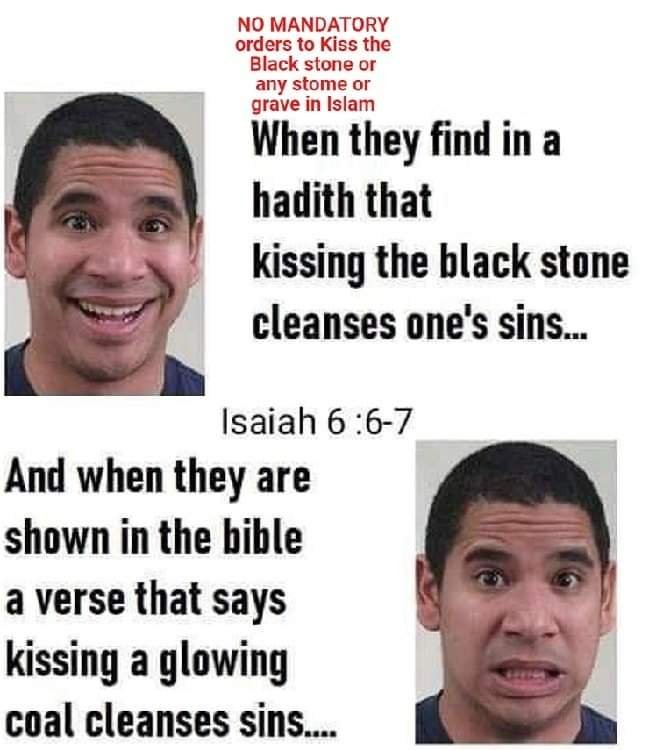
𝐖𝐞 𝐬𝐡𝐚𝐥𝐥 𝐝𝐞𝐬𝐜𝐫𝐢𝐛𝐞 𝐭𝐡𝐞 𝐩𝐡𝐲𝐬𝐢𝐜𝐚𝐥 𝐧𝐚𝐭𝐮𝐫𝐞 𝐨𝐟 𝐭𝐡𝐞 𝐒𝐭𝐨𝐧𝐞 𝐢𝐭𝐬𝐞𝐥𝐟. 𝐓𝐡𝐞 𝐁𝐥𝐚𝐜𝐤 𝐒𝐭𝐨𝐧𝐞 (𝐀𝐫: ٱلْحَجَرُ ٱلْأَسْوَد, 𝐚𝐥-𝐇𝐚𝐣𝐚𝐫 𝐚𝐥-𝐀𝐬𝐰𝐚𝐝) 𝐢𝐬 𝐛𝐮𝐢𝐥𝐭 𝐢𝐧𝐭𝐨 𝐭𝐡𝐞 𝐊𝐚𝐚𝐛𝐚 𝐰𝐚𝐥𝐥, 𝐚𝐭 𝐭𝐡𝐞 𝐞𝐚𝐬𝐭𝐞𝐫𝐧 𝐜𝐨𝐫𝐧𝐞𝐫 𝐨𝐟 𝐭𝐡𝐞 𝐊𝐚𝐚𝐛𝐚, 𝐚𝐛𝐨𝐮𝐭 𝟓 𝐟𝐭. 𝐚𝐛𝐨𝐯𝐞 𝐭𝐡𝐞 𝐠𝐫𝐨𝐮𝐧𝐝 𝐥𝐞𝐯𝐞𝐥, 𝐧𝐨𝐭 𝐯𝐞𝐫𝐲 𝐟𝐚𝐫 𝐟𝐫𝐨𝐦 𝐭𝐡𝐞 𝐝𝐨𝐨𝐫 𝐨𝐟 𝐭𝐡𝐞 𝐊𝐚𝐚𝐛𝐚. 𝐓𝐡𝐞 𝐊𝐚𝐚𝐛𝐚 𝐢𝐭𝐬𝐞𝐥𝐟 𝐜𝐚𝐧 𝐢𝐭𝐬𝐞𝐥𝐟 𝐛𝐞 𝐝𝐞𝐬𝐜𝐫𝐢𝐛𝐞𝐝 𝐚𝐬 𝐚 𝐛𝐥𝐚𝐜𝐤 𝐛𝐨𝐱, 𝐭𝐡𝐚𝐭 𝐌𝐮𝐬𝐥𝐢𝐦𝐬 𝐟𝐚𝐜𝐞 𝐢𝐧 𝐝𝐚𝐢𝐥𝐲 𝐩𝐫𝐚𝐲𝐞𝐫𝐬.
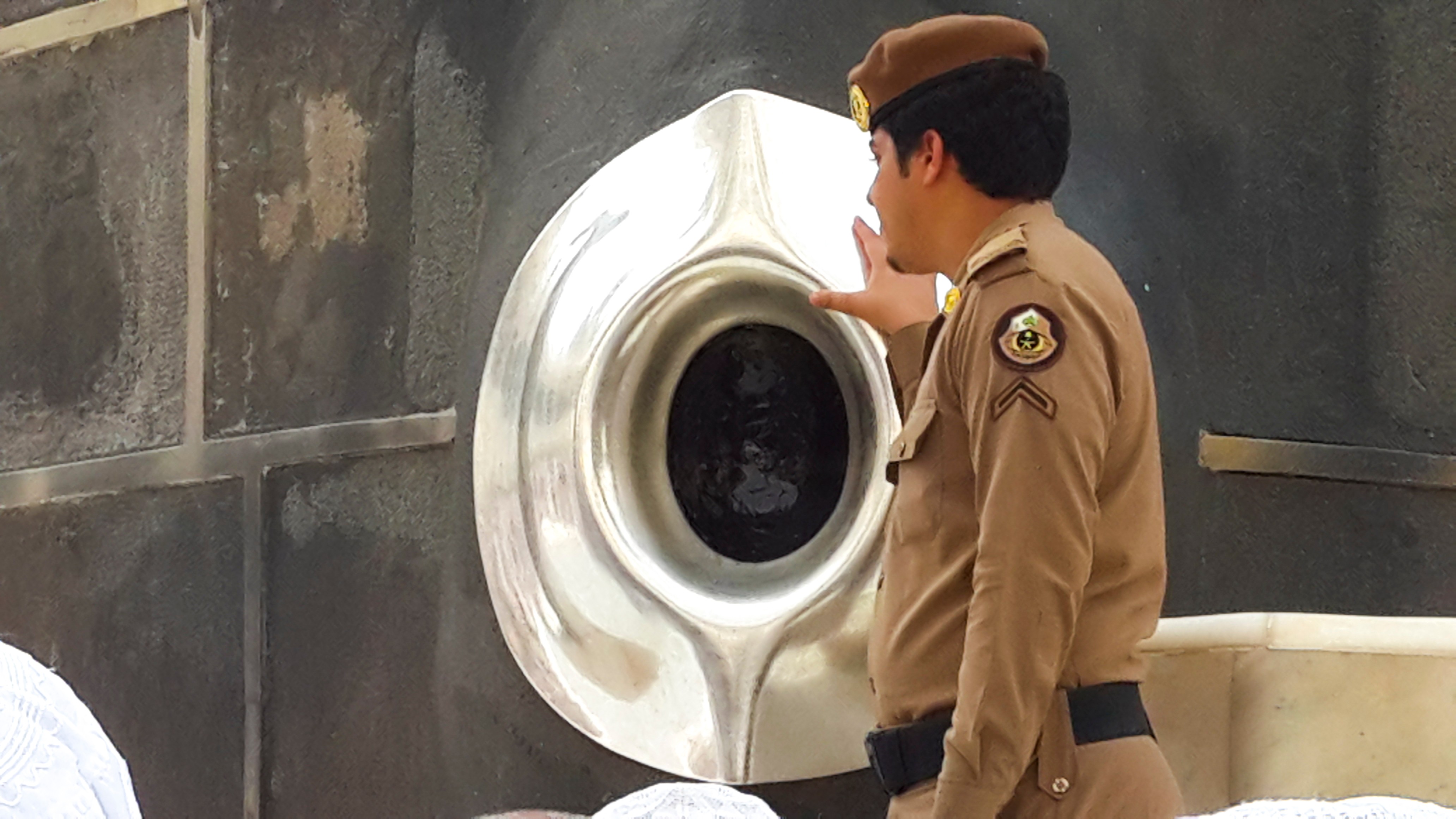
𝐌𝐮𝐬𝐥𝐢𝐦𝐬 𝐛𝐞𝐥𝐢𝐞𝐯𝐞 𝐭𝐡𝐚𝐭 𝐭𝐡𝐞 𝐁𝐥𝐚𝐜𝐤 𝐒𝐭𝐨𝐧𝐞 𝐰𝐚𝐬 𝐨𝐫𝐢𝐠𝐢𝐧𝐚𝐥𝐥𝐲 𝐠𝐢𝐯𝐞𝐧 𝐭𝐨 𝐀𝐛𝐫𝐚𝐡𝐚𝐦, 𝐰𝐡𝐨 𝐛𝐮𝐢𝐥𝐭 𝐭𝐡𝐞 𝐊𝐚𝐚𝐛𝐚 𝐚𝐧𝐝 𝐮𝐬𝐞𝐝 𝐭𝐡𝐞 𝐁𝐥𝐚𝐜𝐤 𝐒𝐭𝐨𝐧𝐞 𝐚𝐬 𝐚 𝐜𝐨𝐫𝐧𝐞𝐫𝐬𝐭𝐨𝐧𝐞 𝐟𝐨𝐫 𝐭𝐡𝐞 𝐬𝐭𝐫𝐮𝐜𝐭𝐮𝐫𝐞. 𝐀𝐛𝐫𝐚𝐡𝐚𝐦 𝐚𝐧𝐝 𝐈𝐬𝐡𝐦𝐚𝐞𝐥 𝐭𝐚𝐮𝐠𝐡𝐭 𝐭𝐡𝐞 𝐞𝐚𝐫𝐥𝐲 𝐌𝐚𝐤𝐤𝐚𝐧 𝐀𝐫𝐚𝐛𝐬 𝐦𝐨𝐧𝐨𝐭𝐡𝐞𝐢𝐬𝐦; 𝐚𝐟𝐭𝐞𝐫 𝐭𝐡𝐞 𝐩𝐚𝐬𝐬𝐢𝐧𝐠 𝐨𝐟 𝐀𝐛𝐫𝐚𝐡𝐚𝐦 𝐚𝐧𝐝 𝐈𝐬𝐡𝐦𝐚𝐞𝐥, 𝐭𝐡𝐞 𝐌𝐚𝐤𝐤𝐚𝐧 𝐀𝐫𝐚𝐛𝐬 𝐰𝐢𝐭𝐡 𝐭𝐢𝐦𝐞 𝐫𝐞𝐠𝐫𝐞𝐬𝐬𝐞𝐝 𝐢𝐧𝐭𝐨 𝐩𝐚𝐠𝐚𝐧 𝐩𝐫𝐚𝐜𝐭𝐢𝐜𝐞𝐬 𝐢𝐧𝐜𝐥𝐮𝐝𝐢𝐧𝐠 𝐢𝐝𝐨𝐥 𝐰𝐨𝐫𝐬𝐡𝐢𝐩. 𝐓𝐡𝐞𝐲 𝐞𝐧𝐝𝐞𝐝 𝐮𝐩 𝐡𝐚𝐯𝐢𝐧𝐠 𝐚 𝐩𝐚𝐧𝐭𝐡𝐞𝐨𝐧 𝐨𝐟 𝐠𝐨𝐝𝐬, 𝐝𝐞𝐬𝐩𝐢𝐭𝐞 𝐭𝐡𝐞 𝐨𝐫𝐢𝐠𝐢𝐧𝐚𝐥 𝐦𝐞𝐬𝐬𝐚𝐠𝐞 𝐨𝐟 𝐀𝐛𝐫𝐚𝐡𝐚𝐦 𝐚𝐧𝐝 𝐈𝐬𝐡𝐦𝐚𝐞𝐥 𝐰𝐡𝐢𝐜𝐡 𝐭𝐚𝐮𝐠𝐡𝐭 𝐭𝐡𝐞 𝐞𝐚𝐫𝐥𝐲 𝐀𝐫𝐚𝐛𝐬 𝐭𝐨 𝐰𝐨𝐫𝐬𝐡𝐢𝐩 𝐆𝐨𝐝 𝐚𝐥𝐨𝐧𝐞 (𝐦𝐨𝐧𝐨𝐭𝐡𝐞𝐢𝐬𝐦).𝟏
𝐆𝐨𝐢𝐧𝐠 𝐛𝐚𝐜𝐤 𝐭𝐨 𝐭𝐡𝐞 𝐁𝐥𝐚𝐜𝐤 𝐒𝐭𝐨𝐧𝐞, 𝐢𝐭 𝐰𝐚𝐬 𝐨𝐫𝐢𝐠𝐢𝐧𝐚𝐥𝐥𝐲 𝐚 𝐬𝐢𝐧𝐠𝐥𝐞 𝐩𝐢𝐞𝐜𝐞 𝐨𝐟 𝐫𝐨𝐜𝐤 𝐛𝐮𝐭 𝐭𝐨𝐝𝐚𝐲 𝐜𝐨𝐧𝐬𝐢𝐬𝐭𝐬 𝐨𝐟 𝐭𝐡𝐫𝐞𝐞 𝐥𝐚𝐫𝐠𝐞 𝐩𝐢𝐞𝐜𝐞𝐬 𝐚𝐧𝐝 𝐬𝐞𝐯𝐞𝐫𝐚𝐥 𝐬𝐦𝐚𝐥𝐥 𝐟𝐫𝐚𝐠𝐦𝐞𝐧𝐭𝐬 (𝐢𝐧 𝐰𝐡𝐢𝐜𝐡 𝐢𝐭 𝐰𝐚𝐬 𝐟𝐨𝐫𝐦𝐞𝐫𝐥𝐲 𝐛𝐫𝐨𝐤𝐞𝐧) 𝐬𝐭𝐮𝐜𝐤 𝐭𝐨𝐠𝐞𝐭𝐡𝐞𝐫 𝐚𝐧𝐝 𝐬𝐮𝐫𝐫𝐨𝐮𝐧𝐝𝐞𝐝 𝐛𝐲 𝐚 𝐥𝐚𝐫𝐠𝐞 𝐫𝐢𝐧𝐠 𝐨𝐟 𝐬𝐭𝐨𝐧𝐞, 𝐰𝐡𝐢𝐜𝐡 𝐢𝐧 𝐭𝐮𝐫𝐧 𝐢𝐬 𝐡𝐞𝐥𝐝 𝐭𝐨𝐠𝐞𝐭𝐡𝐞𝐫 𝐛𝐲 𝐚 𝐬𝐢𝐥𝐯𝐞𝐫 𝐛𝐚𝐧𝐝.
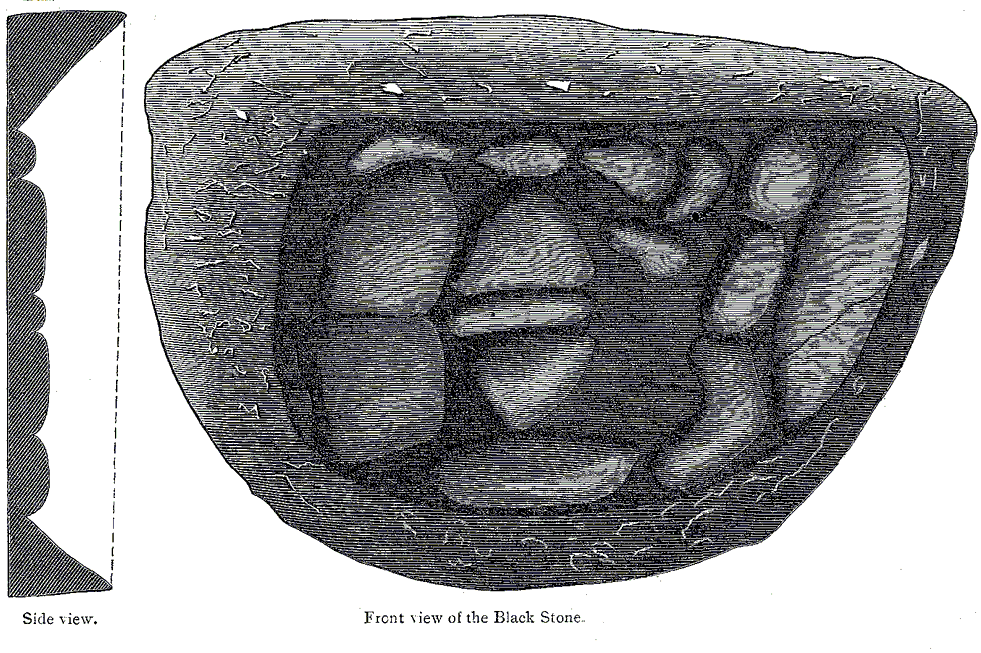
𝐒𝐰𝐢𝐬𝐬 𝐭𝐫𝐚𝐯𝐞𝐥𝐥𝐞𝐫 𝐉𝐨𝐡𝐚𝐧𝐧 𝐋𝐮𝐝𝐰𝐢𝐠 𝐁𝐮𝐫𝐜𝐤𝐡𝐚𝐫𝐝𝐭 𝐯𝐢𝐬𝐢𝐭𝐞𝐝 𝐌𝐞𝐜𝐜𝐚 𝐢𝐧 𝟏𝟖𝟏𝟒, 𝐚𝐧𝐝 𝐩𝐫𝐨𝐯𝐢𝐝𝐞𝐝 𝐚 𝐝𝐞𝐭𝐚𝐢𝐥𝐞𝐝 𝐝𝐞𝐬𝐜𝐫𝐢𝐩𝐭𝐢𝐨𝐧 𝐚𝐬 𝐟𝐨𝐥𝐥𝐨𝐰𝐬:
𝐈𝐭 𝐢𝐬 𝐚𝐧 𝐢𝐫𝐫𝐞𝐠𝐮𝐥𝐚𝐫 𝐨𝐯𝐚𝐥, 𝐚𝐛𝐨𝐮𝐭 𝐬𝐞𝐯𝐞𝐧 𝐢𝐧𝐜𝐡𝐞𝐬 [𝟏𝟖 𝐜𝐦] 𝐢𝐧 𝐝𝐢𝐚𝐦𝐞𝐭𝐞𝐫, 𝐰𝐢𝐭𝐡 𝐚𝐧 𝐮𝐧𝐝𝐮𝐥𝐚𝐭𝐞𝐝 𝐬𝐮𝐫𝐟𝐚𝐜𝐞, 𝐜𝐨𝐦𝐩𝐨𝐬𝐞𝐝 𝐨𝐟 𝐚𝐛𝐨𝐮𝐭 𝐚 𝐝𝐨𝐳𝐞𝐧 𝐬𝐦𝐚𝐥𝐥𝐞𝐫 𝐬𝐭𝐨𝐧𝐞𝐬 𝐨𝐟 𝐝𝐢𝐟𝐟𝐞𝐫𝐞𝐧𝐭 𝐬𝐢𝐳𝐞𝐬 𝐚𝐧𝐝 𝐬𝐡𝐚𝐩𝐞𝐬, 𝐰𝐞𝐥𝐥 𝐣𝐨𝐢𝐧𝐞𝐝 𝐭𝐨𝐠𝐞𝐭𝐡𝐞𝐫 𝐰𝐢𝐭𝐡 𝐚 𝐬𝐦𝐚𝐥𝐥 𝐪𝐮𝐚𝐧𝐭𝐢𝐭𝐲 𝐨𝐟 𝐜𝐞𝐦𝐞𝐧𝐭, 𝐚𝐧𝐝 𝐩𝐞𝐫𝐟𝐞𝐜𝐭𝐥𝐲 𝐰𝐞𝐥𝐥 𝐬𝐦𝐨𝐨𝐭𝐡𝐞𝐝; 𝐢𝐭 𝐥𝐨𝐨𝐤𝐬 𝐚𝐬 𝐢𝐟 𝐭𝐡𝐞 𝐰𝐡𝐨𝐥𝐞 𝐡𝐚𝐝 𝐛𝐞𝐞𝐧 𝐛𝐫𝐨𝐤𝐞𝐧 𝐢𝐧𝐭𝐨 𝐚𝐬 𝐦𝐚𝐧𝐲 𝐩𝐢𝐞𝐜𝐞𝐬 𝐛𝐲 𝐚 𝐯𝐢𝐨𝐥𝐞𝐧𝐭 𝐛𝐥𝐨𝐰, 𝐚𝐧𝐝 𝐭𝐡𝐞𝐧 𝐮𝐧𝐢𝐭𝐞𝐝 𝐚𝐠𝐚𝐢𝐧.
𝐈𝐭 𝐢𝐬 𝐯𝐞𝐫𝐲 𝐝𝐢𝐟𝐟𝐢𝐜𝐮𝐥𝐭 𝐭𝐨 𝐝𝐞𝐭𝐞𝐫𝐦𝐢𝐧𝐞 𝐚𝐜𝐜𝐮𝐫𝐚𝐭𝐞𝐥𝐲 𝐭𝐡𝐞 𝐪𝐮𝐚𝐥𝐢𝐭𝐲 𝐨𝐟 𝐭𝐡𝐢𝐬 𝐬𝐭𝐨𝐧𝐞 𝐰𝐡𝐢𝐜𝐡 𝐡𝐚𝐬 𝐛𝐞𝐞𝐧 𝐰𝐨𝐫𝐧 𝐭𝐨 𝐢𝐭𝐬 𝐩𝐫𝐞𝐬𝐞𝐧𝐭 𝐬𝐮𝐫𝐟𝐚𝐜𝐞 𝐛𝐲 𝐭𝐡𝐞 𝐦𝐢𝐥𝐥𝐢𝐨𝐧𝐬 𝐨𝐟 𝐭𝐨𝐮𝐜𝐡𝐞𝐬 𝐚𝐧𝐝 𝐤𝐢𝐬𝐬𝐞𝐬 𝐢𝐭 𝐡𝐚𝐬 𝐫𝐞𝐜𝐞𝐢𝐯𝐞𝐝. 𝐈𝐭 𝐚𝐩𝐩𝐞𝐚𝐫𝐞𝐝 𝐭𝐨 𝐦𝐞 𝐥𝐢𝐤𝐞 𝐚 𝐥𝐚𝐯𝐚, 𝐜𝐨𝐧𝐭𝐚𝐢𝐧𝐢𝐧𝐠 𝐬𝐞𝐯𝐞𝐫𝐚𝐥 𝐬𝐦𝐚𝐥𝐥 𝐞𝐱𝐭𝐫𝐚𝐧𝐞𝐨𝐮𝐬 𝐩𝐚𝐫𝐭𝐢𝐜𝐥𝐞𝐬 𝐨𝐟 𝐚 𝐰𝐡𝐢𝐭𝐢𝐬𝐡 𝐚𝐧𝐝 𝐨𝐟 𝐚 𝐲𝐞𝐥𝐥𝐨𝐰 𝐬𝐮𝐛𝐬𝐭𝐚𝐧𝐜𝐞.
𝐈𝐭𝐬 𝐜𝐨𝐥𝐨𝐮𝐫 𝐢𝐬 𝐧𝐨𝐰 𝐚 𝐝𝐞𝐞𝐩 𝐫𝐞𝐝𝐝𝐢𝐬𝐡 𝐛𝐫𝐨𝐰𝐧 𝐚𝐩𝐩𝐫𝐨𝐚𝐜𝐡𝐢𝐧𝐠 𝐭𝐨 𝐛𝐥𝐚𝐜𝐤. 𝐈𝐭 𝐢𝐬 𝐬𝐮𝐫𝐫𝐨𝐮𝐧𝐝𝐞𝐝 𝐨𝐧 𝐚𝐥𝐥 𝐬𝐢𝐝𝐞𝐬 𝐛𝐲 𝐚 𝐛𝐨𝐫𝐝𝐞𝐫 𝐜𝐨𝐦𝐩𝐨𝐬𝐞𝐝 𝐨𝐟 𝐚 𝐬𝐮𝐛𝐬𝐭𝐚𝐧𝐜𝐞 𝐰𝐡𝐢𝐜𝐡 𝐈 𝐭𝐨𝐨𝐤 𝐭𝐨 𝐛𝐞 𝐚 𝐜𝐥𝐨𝐬𝐞 𝐜𝐞𝐦𝐞𝐧𝐭 𝐨𝐟 𝐩𝐢𝐭𝐜𝐡 𝐚𝐧𝐝 𝐠𝐫𝐚𝐯𝐞𝐥 𝐨𝐟 𝐚 𝐬𝐢𝐦𝐢𝐥𝐚𝐫, 𝐛𝐮𝐭 𝐧𝐨𝐭 𝐪𝐮𝐢𝐭𝐞 𝐭𝐡𝐞 𝐬𝐚𝐦𝐞, 𝐛𝐫𝐨𝐰𝐧𝐢𝐬𝐡 𝐜𝐨𝐥𝐨𝐮𝐫.
𝐓𝐡𝐢𝐬 𝐛𝐨𝐫𝐝𝐞𝐫 𝐬𝐞𝐫𝐯𝐞𝐬 𝐭𝐨 𝐬𝐮𝐩𝐩𝐨𝐫𝐭 𝐢𝐭𝐬 𝐝𝐞𝐭𝐚𝐜𝐡𝐞𝐝 𝐩𝐢𝐞𝐜𝐞𝐬; 𝐢𝐭 𝐢𝐬 𝐭𝐰𝐨 𝐨𝐫 𝐭𝐡𝐫𝐞𝐞 𝐢𝐧𝐜𝐡𝐞𝐬 𝐢𝐧 𝐛𝐫𝐞𝐚𝐝𝐭𝐡, 𝐚𝐧𝐝 𝐫𝐢𝐬𝐞𝐬 𝐚 𝐥𝐢𝐭𝐭𝐥𝐞 𝐚𝐛𝐨𝐯𝐞 𝐭𝐡𝐞 𝐬𝐮𝐫𝐟𝐚𝐜𝐞 𝐨𝐟 𝐭𝐡𝐞 𝐬𝐭𝐨𝐧𝐞. 𝐁𝐨𝐭𝐡 𝐭𝐡𝐞 𝐛𝐨𝐫𝐝𝐞𝐫 𝐚𝐧𝐝 𝐭𝐡𝐞 𝐬𝐭𝐨𝐧𝐞 𝐢𝐭𝐬𝐞𝐥𝐟 𝐚𝐫𝐞 𝐞𝐧𝐜𝐢𝐫𝐜𝐥𝐞𝐝 𝐛𝐲 𝐚 𝐬𝐢𝐥𝐯𝐞𝐫 𝐛𝐚𝐧𝐝, 𝐛𝐫𝐨𝐚𝐝𝐞𝐫 𝐛𝐞𝐥𝐨𝐰 𝐭𝐡𝐚𝐧 𝐚𝐛𝐨𝐯𝐞, 𝐚𝐧𝐝 𝐨𝐧 𝐭𝐡𝐞 𝐭𝐰𝐨 𝐬𝐢𝐝𝐞𝐬, 𝐰𝐢𝐭𝐡 𝐚 𝐜𝐨𝐧𝐬𝐢𝐝𝐞𝐫𝐚𝐛𝐥𝐞 𝐬𝐰𝐞𝐥𝐥𝐢𝐧𝐠 𝐛𝐞𝐥𝐨𝐰, 𝐚𝐬 𝐢𝐟 𝐚 𝐩𝐚𝐫𝐭 𝐨𝐟 𝐭𝐡𝐞 𝐬𝐭𝐨𝐧𝐞 𝐰𝐞𝐫𝐞 𝐡𝐢𝐝𝐝𝐞𝐧 𝐮𝐧𝐝𝐞𝐫 𝐢𝐭. 𝐓𝐡𝐞 𝐥𝐨𝐰𝐞𝐫 𝐩𝐚𝐫𝐭 𝐨𝐟 𝐭𝐡𝐞 𝐛𝐨𝐫𝐝𝐞𝐫 𝐢𝐬 𝐬𝐭𝐮𝐝𝐝𝐞𝐝 𝐰𝐢𝐭𝐡 𝐬𝐢𝐥𝐯𝐞𝐫 𝐧𝐚𝐢𝐥𝐬.𝟐
𝐈𝐭 𝐰𝐚𝐬 𝐧𝐚𝐫𝐫𝐚𝐭𝐞𝐝 𝐭𝐡𝐚𝐭 𝐈𝐛𝐧 ‘𝐀𝐛𝐛𝐚𝐚𝐬 𝐬𝐚𝐢𝐝: 𝐓𝐡𝐞 𝐌𝐞𝐬𝐬𝐞𝐧𝐠𝐞𝐫 𝐨𝐟 𝐀𝐥𝐥𝐚𝐡 (𝐩𝐞𝐚𝐜𝐞 𝐚𝐧𝐝 𝐛𝐥𝐞𝐬𝐬𝐢𝐧𝐠𝐬 𝐨𝐟 𝐀𝐥𝐥𝐚𝐡 𝐛𝐞 𝐮𝐩𝐨𝐧 𝐡𝐢𝐦) 𝐬𝐚𝐢𝐝: “𝐓𝐡𝐞 𝐁𝐥𝐚𝐜𝐤 𝐒𝐭𝐨𝐧𝐞 𝐜𝐚𝐦𝐞 𝐝𝐨𝐰𝐧 𝐟𝐫𝐨𝐦 𝐏𝐚𝐫𝐚𝐝𝐢𝐬𝐞.”𝟑
𝐌𝐚𝐭𝐞𝐫𝐢𝐚𝐥 𝐨𝐟 𝐭𝐡𝐞 𝐁𝐥𝐚𝐜𝐤 𝐒𝐭𝐨𝐧𝐞
𝐓𝐡𝐞 𝐦𝐚𝐭𝐞𝐫𝐢𝐚𝐥 𝐨𝐟 𝐭𝐡𝐞 𝐁𝐥𝐚𝐜𝐤 𝐒𝐭𝐨𝐧𝐞 𝐡𝐚𝐬 𝐧𝐨𝐭 𝐛𝐞𝐞𝐧 𝐩𝐫𝐞𝐜𝐢𝐬𝐞𝐥𝐲 𝐝𝐞𝐭𝐞𝐫𝐦𝐢𝐧𝐞𝐝. 𝐈𝐭 𝐢𝐬 𝐬𝐨𝐦𝐞𝐭𝐢𝐦𝐞𝐬 𝐜𝐥𝐚𝐬𝐬𝐢𝐟𝐢𝐞𝐝 𝐚𝐬 𝐥𝐚𝐯𝐚 𝐚𝐧𝐝 𝐬𝐨𝐦𝐞𝐭𝐢𝐦𝐞𝐬 𝐚𝐬 𝐛𝐚𝐬𝐚𝐥𝐭. 𝐓𝐡𝐞 𝐫𝐞𝐚𝐬𝐨𝐧 𝐟𝐨𝐫 𝐭𝐡𝐢𝐬 𝐝𝐢𝐟𝐟𝐢𝐜𝐮𝐥𝐭𝐲 𝐢𝐬 𝐭𝐡𝐚𝐭 𝐢𝐭𝐬 𝐯𝐢𝐬𝐢𝐛𝐥𝐞 𝐬𝐮𝐫𝐟𝐚𝐜𝐞 𝐢𝐬 𝐰𝐨𝐫𝐧 𝐬𝐦𝐨𝐨𝐭𝐡 𝐛𝐲 𝐡𝐚𝐧𝐝-𝐭𝐨𝐮𝐜𝐡𝐢𝐧𝐠, 𝐞𝐭𝐜𝟒. 𝐈𝐭𝐬 𝐞𝐬𝐭𝐢𝐦𝐚𝐭𝐞𝐝 𝐝𝐢𝐚𝐦𝐞𝐭𝐞𝐫 𝐢𝐬 𝐚𝐩𝐩𝐫𝐨𝐱𝐢𝐦𝐚𝐭𝐞𝐥𝐲 𝟏𝟐″𝟓. 𝐈𝐭𝐬 𝐜𝐨𝐥𝐨𝐮𝐫 𝐢𝐬 𝐫𝐞𝐝𝐝𝐢𝐬𝐡 𝐛𝐥𝐚𝐜𝐤 𝐰𝐢𝐭𝐡 𝐫𝐞𝐝 𝐚𝐧𝐝 𝐲𝐞𝐥𝐥𝐨𝐰 𝐩𝐚𝐫𝐭𝐢𝐜𝐥𝐞𝐬
.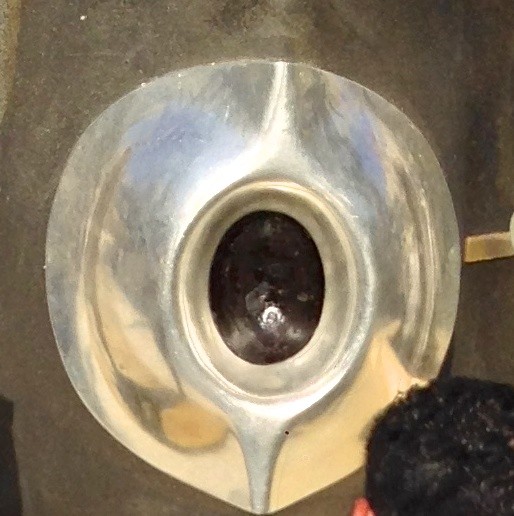
𝐒𝐨𝐦𝐞 𝐈𝐬𝐥𝐚𝐦𝐨𝐩𝐡𝐨𝐛𝐞𝐬 𝐡𝐚𝐯𝐞 𝐛𝐞𝐠𝐮𝐧 𝐚 𝐛𝐚𝐬𝐞𝐥𝐞𝐬𝐬 𝐚𝐭𝐭𝐚𝐜𝐤 𝐨𝐧 𝐭𝐡𝐞 𝐚𝐩𝐩𝐞𝐚𝐫𝐚𝐧𝐜𝐞 𝐨𝐟 𝐭𝐡𝐞 𝐁𝐥𝐚𝐜𝐤 𝐒𝐭𝐨𝐧𝐞 𝐛𝐲 𝐚𝐥𝐥𝐞𝐠𝐢𝐧𝐠 𝐭𝐡𝐚𝐭 𝐢𝐭 𝐥𝐨𝐨𝐤𝐬 𝐥𝐢𝐤𝐞 𝐚 𝐯𝐚𝐠𝐢𝐧𝐚 𝐢𝐧 𝐨𝐫𝐝𝐞𝐫 𝐭𝐨 𝐢𝐧𝐬𝐮𝐥𝐭 𝐌𝐮𝐬𝐥𝐢𝐦𝐬. 𝐓𝐡𝐞 𝐬𝐢𝐥𝐯𝐞𝐫 𝐟𝐫𝐚𝐦𝐞 𝐚𝐫𝐨𝐮𝐧𝐝 𝐭𝐡𝐞 𝐁𝐥𝐚𝐜𝐤 𝐒𝐭𝐨𝐧𝐞 𝐰𝐞𝐫𝐞 𝐟𝐨𝐫 𝐜𝐞𝐧𝐭𝐮𝐫𝐢𝐞𝐬 𝐦𝐚𝐢𝐧𝐭𝐚𝐢𝐧𝐞𝐝 𝐛𝐲 𝐭𝐡𝐞 𝐎𝐭𝐭𝐨𝐦𝐚𝐧 𝐒𝐮𝐥𝐭𝐚𝐧𝐬 𝐢𝐧 𝐭𝐡𝐞𝐢𝐫 𝐫𝐨𝐥𝐞 𝐚𝐬 𝐂𝐮𝐬𝐭𝐨𝐝𝐢𝐚𝐧 𝐨𝐟 𝐭𝐡𝐞 𝐓𝐰𝐨 𝐇𝐨𝐥𝐲 𝐌𝐨𝐬𝐪𝐮𝐞𝐬. 𝐓𝐡𝐢𝐬 𝐬𝐢𝐥𝐯𝐞𝐫 𝐟𝐫𝐚𝐦𝐞 𝐢𝐬 𝐚 𝐦𝐨𝐝𝐞𝐫𝐧 𝐚𝐝𝐝𝐢𝐭𝐢𝐨𝐧 𝐚𝐧𝐝 𝐭𝐡𝐞 𝐬𝐭𝐫𝐮𝐜𝐭𝐮𝐫𝐞 𝐥𝐨𝐨𝐤 𝐝𝐨𝐮𝐠𝐡𝐧𝐮𝐭 𝐬𝐡𝐚𝐩𝐞𝐝 𝐚𝐬 𝐚 𝐫𝐞𝐬𝐮𝐥𝐭. 𝐓𝐡𝐞 𝐟𝐫𝐚𝐦𝐞𝐬 𝐰𝐨𝐫𝐞 𝐨𝐮𝐭 𝐨𝐯𝐞𝐫 𝐭𝐢𝐦𝐞 𝐝𝐮𝐞 𝐭𝐨 𝐭𝐡𝐞 𝐜𝐨𝐧𝐬𝐭𝐚𝐧𝐭 𝐡𝐚𝐧𝐝𝐥𝐢𝐧𝐠 𝐛𝐲 𝐩𝐢𝐥𝐠𝐫𝐢𝐦𝐬 𝐚𝐧𝐝 𝐰𝐞𝐫𝐞 𝐩𝐞𝐫𝐢𝐨𝐝𝐢𝐜𝐚𝐥𝐥𝐲 𝐫𝐞𝐩𝐥𝐚𝐜𝐞𝐝.
𝐈𝐭 𝐢𝐬 𝐫𝐞𝐩𝐨𝐫𝐭𝐞𝐝 𝐭𝐡𝐚𝐭 𝐰𝐡𝐞𝐧 𝐭𝐡𝐞 𝐏𝐫𝐨𝐩𝐡𝐞𝐭 𝐌𝐮𝐡𝐚𝐦𝐦𝐚𝐝(𝐏) 𝐞𝐧𝐭𝐞𝐫𝐞𝐝 𝐭𝐡𝐞 𝐜𝐢𝐭𝐲 𝐨𝐟 𝐌𝐚𝐤𝐤𝐚𝐡 𝐚𝐬 𝐚 𝐯𝐢𝐜𝐭𝐨𝐫𝐢𝐨𝐮𝐬 𝐥𝐞𝐚𝐝𝐞𝐫, 𝐭𝐡𝐞𝐫𝐞 𝐰𝐞𝐫𝐞 𝟑𝟔𝟎 𝐢𝐝𝐨𝐥𝐬 𝐚𝐫𝐨𝐮𝐧𝐝 𝐭𝐡𝐞 𝐊𝐚𝐚𝐛𝐚𝟔. 𝐓𝐡𝐞 𝐏𝐫𝐨𝐩𝐡𝐞𝐭(𝐏) 𝐭𝐡𝐞𝐧 𝐡𝐚𝐝 𝐭𝐡𝐞 𝐅𝐨𝐫𝐛𝐢𝐝𝐝𝐞𝐧 𝐒𝐚𝐧𝐜𝐭𝐮𝐚𝐫𝐲 (𝐭𝐡𝐞 𝐩𝐫𝐞𝐜𝐢𝐧𝐜𝐭 𝐚𝐫𝐨𝐮𝐧𝐝 𝐭𝐡𝐞 𝐊𝐚𝐚𝐛𝐚 𝐩𝐫𝐨𝐩𝐞𝐫) 𝐜𝐥𝐞𝐚𝐧𝐬𝐞𝐝 𝐨𝐟 𝐚𝐥𝐥 𝐭𝐡𝐞𝐬𝐞 𝐢𝐝𝐨𝐥𝐬 𝐚𝐧𝐝 𝐩𝐫𝐨𝐜𝐥𝐚𝐢𝐦𝐞𝐝 𝐌𝐨𝐧𝐨𝐭𝐡𝐞𝐢𝐬𝐦 𝐢𝐧 𝐢𝐭𝐬 𝐭𝐫𝐮𝐞, 𝐦𝐨𝐬𝐭 𝐞𝐥𝐞𝐯𝐚𝐭𝐞𝐝 𝐚𝐧𝐝 𝐩𝐫𝐢𝐬𝐭𝐢𝐧𝐞 𝐟𝐨𝐫𝐦.
𝐓𝐡𝐮𝐬 𝐬𝐚𝐲𝐢𝐧𝐠 𝐭𝐡𝐚𝐭 “𝐌𝐮𝐬𝐥𝐢𝐦𝐬 𝐰𝐨𝐫𝐬𝐡𝐢𝐩 𝐭𝐡𝐞 𝐁𝐥𝐚𝐜𝐤 𝐒𝐭𝐨𝐧𝐞 𝐚𝐬 𝐚𝐧 𝐢𝐝𝐨𝐥” 𝐢𝐬 𝐜𝐥𝐞𝐚𝐫𝐥𝐲 𝐭𝐡𝐞 𝐦𝐨𝐬𝐭 𝐚𝐛𝐬𝐮𝐫𝐝 𝐭𝐡𝐢𝐧𝐠 𝐞𝐯𝐞𝐫 𝐩𝐫𝐨𝐧𝐨𝐮𝐧𝐜𝐞𝐝 𝐢𝐧 𝐭𝐡𝐞 𝐡𝐢𝐬𝐭𝐨𝐫𝐲 𝐨𝐟 𝐦𝐚𝐧𝐤𝐢𝐧𝐝.
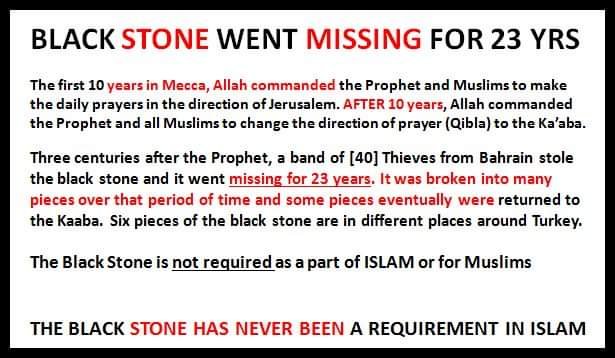
𝐒𝐢𝐠𝐧𝐢𝐟𝐢𝐜𝐚𝐧𝐜𝐞 𝐨𝐟 𝐭𝐡𝐞 𝐁𝐥𝐚𝐜𝐤 𝐒𝐭𝐨𝐧𝐞
𝐅𝐫𝐨𝐦 𝐚 𝐩𝐡𝐲𝐬𝐢𝐜𝐚𝐥 𝐩𝐞𝐫𝐬𝐩𝐞𝐜𝐭𝐢𝐯𝐞, 𝐭𝐡𝐞𝐫𝐞𝐟𝐨𝐫𝐞, 𝐭𝐡𝐞 𝐁𝐥𝐚𝐜𝐤 𝐒𝐭𝐨𝐧𝐞 𝐝𝐨𝐞𝐬 𝐧𝐨𝐭 𝐡𝐚𝐯𝐞 𝐚𝐧𝐲 𝐬𝐩𝐞𝐜𝐢𝐚𝐥 𝐬𝐢𝐠𝐧𝐢𝐟𝐢𝐜𝐚𝐧𝐜𝐞 𝐨𝐫 𝐢𝐦𝐩𝐨𝐫𝐭𝐚𝐧𝐜𝐞.
𝐔𝐦𝐚𝐫(𝐑), 𝐥𝐚𝐭𝐞𝐫 𝐭𝐨 𝐛𝐞𝐜𝐨𝐦𝐞 𝐭𝐡𝐞 𝐬𝐞𝐜𝐨𝐧𝐝 𝐂𝐚𝐥𝐢𝐩𝐡 𝐨𝐟 𝐈𝐬𝐥𝐚𝐦, 𝐢𝐬 𝐫𝐞𝐩𝐨𝐫𝐭𝐞𝐝 𝐭𝐨 𝐡𝐚𝐯𝐞 𝐬𝐚𝐢𝐝 𝐭𝐡𝐚𝐭 𝐡𝐞 𝐟𝐮𝐥𝐥𝐲 𝐫𝐞𝐚𝐥𝐢𝐳𝐞𝐝 𝐭𝐡𝐚𝐭 𝐭𝐡𝐞 𝐁𝐥𝐚𝐜𝐤 𝐒𝐭𝐨𝐧𝐞 𝐰𝐚𝐬 𝐦𝐞𝐫𝐞𝐥𝐲 𝐚 𝐬𝐭𝐨𝐧𝐞 𝐚𝐧𝐝 𝐭𝐡𝐮𝐬 𝐡𝐚𝐝 𝐧𝐨 𝐩𝐨𝐰𝐞𝐫 𝐨𝐟 𝐢𝐭𝐬 𝐨𝐰𝐧 𝐭𝐨 𝐡𝐚𝐫𝐦 𝐨𝐫 𝐛𝐞𝐧𝐞𝐟𝐢𝐭 𝐚𝐧𝐲𝐨𝐧𝐞𝟕.
𝐀𝐬 𝐟𝐨𝐫 𝐭𝐡𝐞 𝐫𝐞𝐚𝐬𝐨𝐧𝐬 𝐚𝐬 𝐭𝐨 𝐰𝐡𝐲 𝐰𝐞 𝐡𝐚𝐯𝐞 𝐭𝐡𝐞 𝐁𝐥𝐚𝐜𝐤 𝐒𝐭𝐨𝐧𝐞 𝐢𝐧 𝐭𝐡𝐞 𝐰𝐚𝐥𝐥 𝐨𝐟 𝐭𝐡𝐞 𝐊𝐚𝐚𝐛𝐚, 𝐰𝐞 𝐫𝐞𝐚𝐝 𝐚𝐛𝐨𝐮𝐭 𝐭𝐡𝐞 𝐟𝐨𝐥𝐥𝐨𝐰𝐢𝐧𝐠 𝐫𝐞𝐚𝐬𝐨𝐧𝐬, 𝐭𝐡𝐚𝐭:
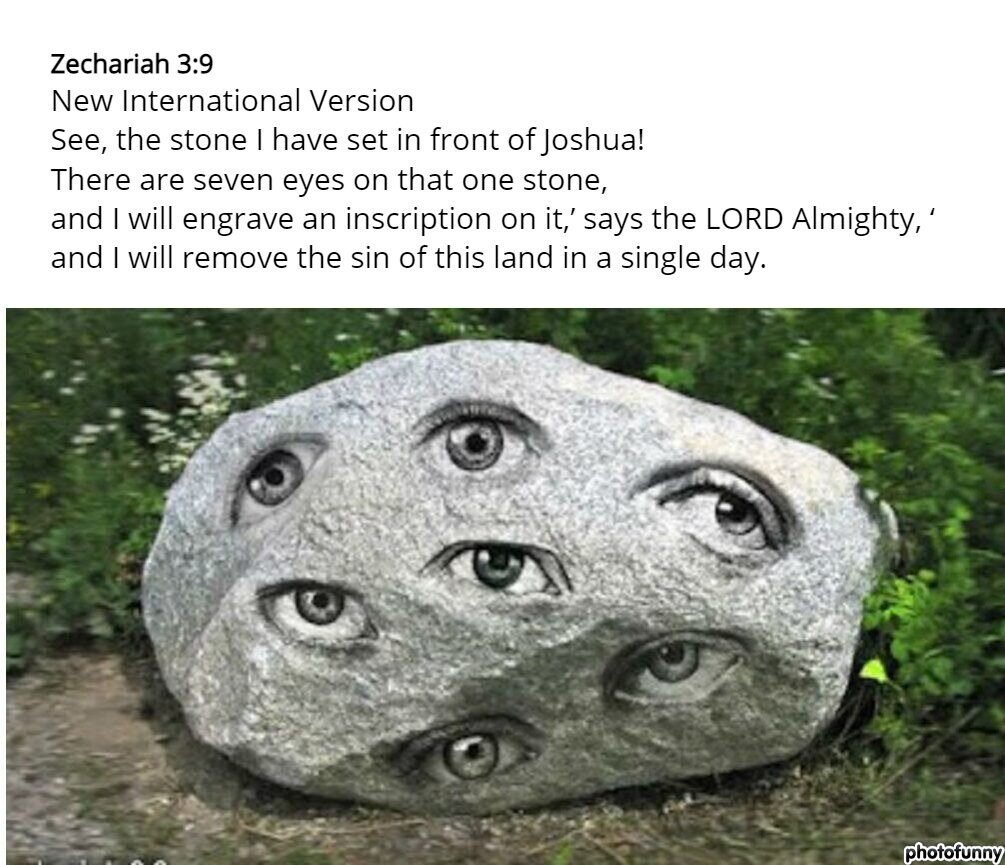
𝐀𝐥𝐥𝐚𝐡 𝐊𝐧𝐨𝐰𝐬 𝐁𝐞𝐬𝐭.
𝐑𝐞𝐟𝐞𝐫𝐞𝐧𝐜𝐞𝐬:
Kissing in reference to the black stone.
Why there is a gender mixing during Hajj and Umrah – Pilgrimage in Mecca?
Why Muslims Walk Around The ‘Kaaba’ in the Haram Mosque in Mecca
Why do Muslims kiss the Kaaba stone?
Malicious Allegations About the Black Stone and Their Refutations
Black stone in Mecca worship Refutation
Kissing Stone and forgiveness of sins from the Bible!
Idol Worship, the Unforgivable Sin in Islam (if maintained until death)
Does Surah 53:19-23 in the Qur’an tell Muslims to worship al-Lat, al-Uzza, and Manat?
No Paganism in Islam or Hajj=Pligrimage to Mecca
Christian hypocrisy regarding Muslims praying facing Mecca.
𝐀𝐧𝐝 𝐰𝐢𝐭𝐡 𝐭𝐡𝐢𝐬, 𝐢𝐭 𝐢𝐬 𝐜𝐥𝐞𝐚𝐫 𝐭𝐡𝐚𝐭 𝐭𝐡𝐢𝐬 𝐛𝐚𝐬𝐞𝐥𝐞𝐬𝐬 𝐚𝐬𝐬𝐞𝐫𝐭𝐢𝐨𝐧 𝐨𝐟 𝐈𝐬𝐥𝐚𝐦𝐨𝐩𝐡𝐨𝐛𝐞𝐬 𝐢𝐬 𝐫𝐞𝐟𝐮𝐭𝐞𝐝. 𝐀𝐧𝐝 𝐨𝐧𝐥𝐲 𝐆𝐨𝐝 𝐤𝐧𝐨𝐰𝐬 𝐛𝐞𝐬𝐭!𝐂𝐢𝐭𝐞 𝐭𝐡𝐢𝐬 𝐚𝐫𝐭𝐢𝐜𝐥𝐞 𝐚𝐬: 𝐁𝐢𝐬𝐦𝐢𝐤𝐚 𝐀𝐥𝐥𝐚𝐡𝐮𝐦𝐚 𝐓𝐞𝐚𝐦, “𝐃𝐨 𝐌𝐮𝐬𝐥𝐢𝐦𝐬 𝐖𝐨𝐫𝐬𝐡𝐢𝐩 𝐓𝐡𝐞 𝐁𝐥𝐚𝐜𝐤 𝐒𝐭𝐨𝐧𝐞 𝐎𝐟 𝐓𝐡𝐞 𝐊𝐚𝐚𝐛𝐚?,” 𝐢𝐧 𝐁𝐢𝐬𝐦𝐢𝐤𝐚 𝐀𝐥𝐥𝐚𝐡𝐮𝐦𝐚, 𝐎𝐜𝐭𝐨𝐛𝐞𝐫 𝟏𝟓, 𝟐𝟎𝟎𝟓, 𝐥𝐚𝐬𝐭 𝐚𝐜𝐜𝐞𝐬𝐬𝐞𝐝 𝐎𝐜𝐭𝐨𝐛𝐞𝐫 𝟏𝟗, 𝟐𝟎𝟐𝟏
𝐒𝐚𝐟𝐢-𝐮𝐫-𝐑𝐚𝐡𝐦𝐚𝐧 𝐀𝐥-𝐌𝐮𝐛𝐚𝐫𝐚𝐤𝐩𝐮𝐫𝐢, 𝐀𝐫-𝐑𝐚𝐡𝐞𝐞𝐪𝐮𝐥-𝐌𝐚𝐤𝐡𝐭𝐮𝐦 (𝐃𝐚𝐫𝐮𝐬𝐬𝐚𝐥𝐚𝐦, 𝟐𝟎𝟎𝟐), 𝐩𝐩. 𝟐𝟔-𝟐𝟖
𝐁𝐮𝐫𝐜𝐤𝐡𝐚𝐫𝐝𝐭, 𝐉𝐨𝐡𝐚𝐧𝐧 𝐋𝐮𝐝𝐰𝐢𝐠 (𝟏𝟖𝟐𝟗). 𝐓𝐫𝐚𝐯𝐞𝐥𝐬 𝐢𝐧 𝐀𝐫𝐚𝐛𝐢𝐚, 𝐂𝐨𝐦𝐩𝐫𝐞𝐡𝐞𝐧𝐝𝐢𝐧𝐠 𝐚𝐧 𝐀𝐜𝐜𝐨𝐮𝐧𝐭 𝐨𝐟 𝐓𝐡𝐨𝐬𝐞 𝐓𝐞𝐫𝐫𝐢𝐭𝐨𝐫𝐢𝐞𝐬 𝐢𝐧 𝐇𝐞𝐝𝐣𝐚𝐳 𝐰𝐡𝐢𝐜𝐡 𝐭𝐡𝐞 𝐌𝐨𝐡𝐚𝐦𝐦𝐞𝐝𝐚𝐧𝐬 𝐑𝐞𝐠𝐚𝐫𝐝 𝐚𝐬 𝐒𝐚𝐜𝐫𝐞𝐝. 𝐇𝐞𝐧𝐫𝐲 𝐂𝐨𝐥𝐛𝐮𝐫𝐧, 𝐍𝐞𝐰 𝐁𝐮𝐫𝐥𝐢𝐧𝐠𝐭𝐨𝐧 𝐒𝐭𝐫𝐞𝐞𝐭. 𝐩. 𝟐𝟓𝟎
𝐍𝐚𝐫𝐫𝐚𝐭𝐞𝐝 𝐛𝐲 𝐚𝐥-𝐓𝐢𝐫𝐦𝐢𝐝𝐡𝐢, 𝟖𝟕𝟕; 𝐚𝐥-𝐍𝐚𝐬𝐚𝐚’𝐢, 𝟐𝟗𝟑𝟓. 𝐓𝐡𝐞 𝐡𝐚𝐝𝐢𝐭𝐡 𝐰𝐚𝐬 𝐜𝐥𝐚𝐬𝐬𝐞𝐝 𝐚𝐬 𝐬𝐚𝐡𝐞𝐞𝐡 𝐛𝐲 𝐚𝐥-𝐓𝐢𝐫𝐦𝐢𝐝𝐡𝐢.
𝐑𝐞𝐟𝐞𝐫, 𝐟𝐨𝐫 𝐞𝐱𝐚𝐦𝐩𝐥𝐞, 𝐭𝐨 𝐭𝐡𝐞 𝐩𝐫𝐨𝐟𝐢𝐥𝐞 𝐬𝐤𝐞𝐭𝐜𝐡 𝐨𝐟 𝐭𝐡𝐞 𝐁𝐥𝐚𝐜𝐤 𝐒𝐭𝐨𝐧𝐞 𝐠𝐢𝐯𝐞𝐧 𝐛𝐲 𝐀𝐥𝐢 𝐁𝐞𝐲: 𝐓𝐫𝐚𝐯𝐞𝐥𝐬, 𝐕𝐨𝐥. 𝐢𝐢 (𝐋𝐨𝐧𝐝𝐨𝐧 𝟏𝟖𝟏𝟔), 𝐩. 𝟕𝟔, 𝐭𝐨 𝐧𝐨𝐭𝐞 𝐢𝐭𝐬 𝐬𝐮𝐫𝐟𝐚𝐜𝐞 𝐡𝐨𝐥𝐥𝐨𝐰𝐞𝐝 𝐨𝐮𝐭 𝐢𝐧 𝐮𝐧𝐝𝐮𝐥𝐚𝐭𝐢𝐨𝐧𝐬.
𝐒𝐞𝐞 𝐚𝐥-𝐁𝐚𝐭𝐚𝐧𝐮𝐧𝐢, 𝐚𝐥-𝐑𝐢𝐡𝐥𝐚 𝐚𝐥-𝐇𝐚𝐳𝐢𝐚𝐡, 𝐂𝐚𝐢𝐫𝐨 (𝟏𝟑𝟐𝟗 𝐀𝐇), 𝐩. 𝟏𝟎𝟓
𝐒𝐞𝐞 𝐒𝐚𝐡𝐢𝐡 𝐁𝐮𝐤𝐡𝐚𝐫𝐢, 𝐕𝐨𝐥𝐮𝐦𝐞 𝟓, 𝐁𝐨𝐨𝐤 𝟓𝟗, 𝐍𝐮𝐦𝐛𝐞𝐫 𝟓𝟖𝟑 (𝐌𝐮𝐡𝐬𝐢𝐧 𝐊𝐡𝐚𝐧’𝐬 𝐭𝐫.)
𝐒𝐞𝐞 𝐭𝐡𝐢𝐬 𝐬𝐭𝐚𝐭𝐞𝐦𝐞𝐧𝐭 𝐢𝐧 𝐯𝐚𝐫𝐢𝐨𝐮𝐬 𝐧𝐚𝐫𝐫𝐚𝐭𝐢𝐯𝐞𝐬, 𝐬𝐮𝐜𝐡 𝐚𝐬: 𝐒𝐚𝐡𝐢𝐡 𝐁𝐮𝐤𝐡𝐚𝐫𝐢, 𝐕𝐨𝐥𝐮𝐦𝐞 𝟐, 𝐁𝐨𝐨𝐤 𝟐𝟔, 𝐍𝐮𝐦𝐛𝐞𝐫𝐬 𝟔𝟔𝟕, 𝟔𝟕𝟓 (𝐌𝐮𝐡𝐬𝐢𝐧 𝐊𝐡𝐚𝐧’𝐬 𝐭𝐫.); 𝐒𝐚𝐡𝐢𝐡 𝐌𝐮𝐬𝐥𝐢𝐦, 𝐁𝐨𝐨𝐤 𝟎𝟎𝟕, 𝐍𝐮𝐦𝐛𝐞𝐫 𝟐𝟗𝟏𝟒 (𝐀𝐛𝐝𝐮𝐥 𝐇𝐚𝐦𝐢𝐝 𝐒𝐢𝐝𝐝𝐢𝐪𝐮𝐢’𝐬 𝐭𝐫.); 𝐒𝐮𝐧𝐚𝐧 𝐚𝐧-𝐍𝐚𝐬𝐚’𝐢 (𝐀𝐫𝐚𝐛𝐢𝐜 𝐯𝐞𝐫𝐬𝐢𝐨𝐧), 𝐕𝐨𝐥. 𝐢𝐢, 𝐩. 𝟑𝟖, 𝐞𝐭𝐜.
𝐒𝐞𝐞 𝐭𝐡𝐞 𝐝𝐞𝐭𝐚𝐢𝐥𝐬 𝐨𝐟 𝐭𝐡𝐢𝐬 𝐩𝐨𝐢𝐧𝐭 𝐢𝐧 𝐌. 𝐇𝐚𝐦𝐢𝐝𝐮𝐥𝐥𝐚𝐡, 𝐈𝐧𝐭𝐫𝐨𝐝𝐮𝐜𝐭𝐢𝐨𝐧 𝐭𝐨 𝐈𝐬𝐥𝐚𝐦, 𝐩𝐚𝐫𝐚𝐠𝐫𝐚𝐩𝐡 𝟏𝟖𝟏/𝐚, 𝐊𝐚𝐫𝐚𝐜𝐡𝐢 𝟏𝟗𝟔𝟗